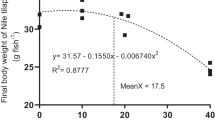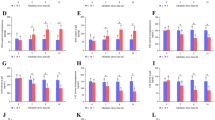Abstract
In juveniles of Atlantic salmon Salmo salar of two age groups (0+ and 1+) living in the mainstream and in the tributary of the subarctic Varzuga River, the activity of some enzymes was determined (cytochrome c oxidase, malate dehydrogenase, lactate dehydrogenase, glucose-6-phosphate dehydrogenase, and 1-glycerophosphate dehydrogenase), reflecting the intensity of the direction of principal pathways of carbohydrate metabolism and of synthesis of ATP. The effect of environmental conditions on growth and development of different age groups is different. Underyearlings (0+) living in the tributary are characterized by an advanced locomotor performance and growth rate. They possess a higher level of aerobic and anaerobic energy metabolism and assimilation of carbohydrates for synthesis of structural and stock compounds in comparison with yearlings living in the mainstream. No significant differences are found between two-summer-old fish (1+) from different habitats in parameters of energy metabolism. This demonstrates that the living conditions for them in the tributary are not so favorable as from underyearlings. The food items in the tributary are small and numerous, i.e., are more available for salmon underyearlings. Parrs 1+ feed on large invertebrates and feeding in the mainstream is preferable. The differences in parameters of energy metabolism of juvenile salmon manifesting themselves in the first year of life make the basis for the fact that the subsequent smoltification of parrs and migration for feeding occur at different ages—2+, 3+, or 4+. This contributes to the formation of the complex age structure of the Varzuga stock of salmon.
Similar content being viewed by others
References
R. Ahmad and A. U. Hasnain, “Ontogenetic Changes and Developmental Adjustments in Lactate Dehydrogenase Isozymes of an Obligate Air-Breathing Fish Channa punctatus during Deprivation of Air Access,” Comp. Biochem. Physiol. Biochem. Mol. Biol., B 140(2), 271–278 (2005).
G. S. Bailey and S. T. Lim, “Evolution of Duplicated Lactate Dehydrogenase Isozymes in Salmon,” J. Biol. Chem. 252(16), 5708–5715 (1977).
I. A. Baryshev, “Amphibiotic Insects from Sites of Rearing Juvenile Atlantic Salmon in the Varzuga River Basin,” in Materials of II All-Russia Symposium on Amphibiotic and Aquatic Insects (Voronezh. Gos. Univ., Voronezh, 2004), pp. 7–13.
I. A. Baryshev, A. E. Veselov, A. V. Zubchenko, and S. M. Kalyuzhin, “Food Resources of Atlantic Salmon in the Varzuga River Basin,” in Biology, Reproduction, and State of Resources of Anadromous and Freshwater Fish of Kola Peninsula (PINRO, Murmansk, 2005), pp. 21–30.
M. Dixon and E. Webb, Enzymes (Longman, London, 1979).
J. Erkinaro, M. Julkunen, and E. Niemela, “Migration of Juvenile Atlantic Salmon Salmo salar in Small Tributaries of the Subarctic River Teno, Northern Finland,” Aquaculture 168, 105–119 (1998).
G. H. Fried and M. P. Schreibman, “Alterations of Pentose Shunt Activity in Tissues of Teleosts,” Comp. Biochem. Physiol. B 42(4), 517–522 (1972).
A. K. Gamperl, K. J. Rodnick, H. A. Faust, et al., “Metabolism, Swimming Performance, and Tissue Biochemistry of High Desert Redband Trout (Oncorhynchus mykiss ssp.): Evidence for Phenotypic Differences in Physiological Function,” Physiol. Biochem. Zool. 75(5), 413–431 (2002).
E. M. Goolish and I. R. Adelman, “Tissue Specific Cytochrome c Oxidase Activity in Largemouth Bass: The Metabolic Cost of Feeding and Growth,” Physiol. Zool. 60, 454–464 (1987).
H. Guderley, “Locomotor Performance and Muscle Metabolic Capacities: Impact of Temperature and Energetic Status,” Comp. Biochem. Physiol. Biochem. Mol. Biol, B 139(3), 371–382 (2004).
P. Hochachka and G. Somero, Strategies of Biochemical Adaptation (Saunders, Philadelphia, 1973).
P. W. Hochachka, C. Stanley, J. Merkt, and J. Sumar-Kalinowski, “Metabolic Meaning of Elevated Levels of Oxidative Enzymes in High Altitude Adapted Animals: An Interpretive Hypothesis,” Respirat. Physiol. 52, 303–313 (1983).
R. V. Kazakov, Biological Bases of Cultivation of Atlantic Salmon (Leg. i Pishch. Prom-st’, Moscow, 1982) [in Russian].
R. V. Kazakov, O. G. Kuz’min, Yu. A. Shustov, and I. L. Shchurov, Atlantic Salmon from the Varzuga River (Gidrometeoizdat, St. Petersburg, 1992) [in Russian].
G. A. Kochetov, Practical Guide on Enzymology (Vysshaya Shkola, Moscow, 1980) [in Russian].
S. T. Lim, R. Kai, and G. S. Bailey, “Lactate Dehydrogenase Isozymes of Salmonid Fish. Evidence for Unique and Rapid Functional Divergence of Duplicated H4 Lactate Dehydrogenase,” J. Biol. Chem. 250(5), 1790–1800 (1975).
L. F. Lysenko and E. G. Berestovskii, Salmon from the Varzuga River. Preprint of a Report (MMBI KarNTs RAN, Murmansk, 1999) [in Russian].
E. Massaro, “The Lactate Dehydrogenase Isozymes of Coregonus hoyigill (Pisces, Salmonidae): Tissue Distribution, Immunochemistry and Molecular Weight,” Comp. Biochem. Physiol., A 46, 353–357 (1973).
E. J. Massaro and C. L. Market, “Isozyme Patterns of Salmonid Fish: Evidence for Multiple Cistron for Lactate Dehydrogenase Polyeptides,” J. Exp. Zool. 168(2), 223–238 (1968).
R. Maurer, Disk-Elektrophores. Theorie und Praxis der diskontinuierlichen Polyacrylamidgel-Elektrophorese (Springer, Heidelberg, 1968).
N. B. Metcalfe and J. E. Thorpe, “Early Predictors of Life-History Events: The Link Between First Feeding Date, Dominance and Seaward Migration in Atlantic Salmon, Salmo salar,” J. Fish Biol. 41, 93–99 (1992).
C. Nathanailides and N. C. Stickland, “Activity of Cytochrome c Oxidase and Lactate Dehydrogenase in Muscle Tissue of Slow Growing (Lower Modal Group) and Fast Growing (Upper Modal Group) Atlantic Salmon,” J. Fish. Biol. 48, 549–551 (1996).
N. D. Ozernyuk, Bioenergetics of Ontogenesis (Mosk. Gos. Univ., Moscow, 2000) [in Russian].
D. S. Pavlov, Biological Bases of Fish Behavior Control in a Water Stream (Nauka, Moscow, 1979) [in Russian].
L. Smith, “Spectrophotometric Assay of Cytochrome c Oxidase,” Methods Biochem. Analysis 24(27) (1955).
Yu. A. Shustov, Ecology of Juvenile Atlantic Salmon (Karelia, Petrozavodsk, 1983) [in Russian].
Yu. A. Shustov, I. L. Shchurov, and A. E. Veselov, “The Effect of Temperature on Physical Capacities of Juvenile Lacustrine Salmon Salmo salar sebago,” Vopr. Ikhtiol. 29(4), 676–677 (1989).
J. R. Treberg, J. M. Lewis, and W. R. Driedzic, “Comparison of Liver Enzymes in Osmerid Fishes: Key Differences Between a Glycerol Accumulating Species, Rainbow Smelt (Osmerus mordax), and a Species That Does Not Accumulate Glycerol, Capelin (Mallotus villosus),” Comp. Biochem. Physiol. Mol. Integr. Physiol. 132(2), 433–438 (2002).
A. E. Veselov and S. M. Kalyuzhin, Ecology, Behavior, and Distribution of Atlantic Salmon (Karelia, Petrozavodsk, 2001) [in Russian].
A. J. Veselov, R. V. Kazakov, M. I. Sysoeva, and I. N. Bahmet, “Ontogenesis of Rheotactic and Optomotor Responses of Juvenile Atlantic Salmon,” Aquaculture 168, 17–26 (1998).
A. V. Zubchenko, O. G. Kuz’min, O. N. Novikov, and A. L. Sorokin, Recreation Catch of Salmon on Kola Peninsula. Program of Development (PINRO, Murmansk, 1991) [in Russian].
Author information
Authors and Affiliations
Corresponding author
Additional information
Original Russian Text © D.S. Palov, O.V. Meshcheryakova, A.E. Veselov, N.N. Nemova, A.I. Lupandin, 2007, published in Voprosy Ikhtiologii, 2007, Vol. 47, No. 6, pp. 819–826.
Rights and permissions
About this article
Cite this article
Pavlov, D.S., Meshcheryakova, O.V., Veselov, A.E. et al. Parameters of energy metabolism in juveniles of Atlantic salmon Salmo salar living in the mainstream and in the tributary of the Varzuga River (the Kola Peninsula). J. Ichthyol. 47, 774–781 (2007). https://doi.org/10.1134/S003294520709010X
Received:
Issue Date:
DOI: https://doi.org/10.1134/S003294520709010X




